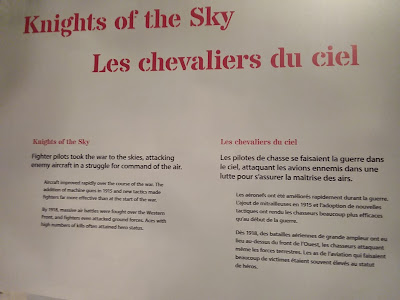The age of flight was new to war; just a decade past the Wright Brothers, planes became part of warfare in the First World War. Unlike other areas of combat in which tactics and strategy developed over time, this was a brand new theatre of combat, and young pilots were inventing an entirely different way of fighting as they went along.
Canada would not have a separate air force until late in the war, but many joined the British services, with the Royal Air Force emerging late in the war out of the Royal Flying Corps and the Royal Naval Air Service.
This is Dogfight, painted by John Armstrong Turnbull circa 1919.
William Barker was one of the aces of the war, one of those who did the impossible time and again and rose to the rank of lieutenant-colonel by the end of the war. He is the most decorated military serviceman in Canadian history.
Some of his medals are here.
And a portion of his plane, a Sopwith Snipe, is also here.
Young men took to the air on both sides; many of them died in what was a hazardous line of duty.
Jim Moses, a First Nations resident, was an observer flying in the Royal Flying Corps, and would not live to see the end of the war.
Alan McLeod would be the youngest recipient of the Victoria Cross.
Captain Roy Brown went down in history as the man who dueled the Red Baron and lived to tell the tale. Though there is some dispute as to if it was Brown or Australian troops on the ground who dealt the fatal shot to Manfred von Richthofen, most credit Brown. In the end it was a favour to the Baron, whose name and honour remained intact, never smeared by association with the Nazis, as surely would have happened had he lived.
Here we have Brown's logbook and medals. I will be continuing this series after the New Year, and moving into Christmas tomorrow.












It´s kinda impressive. I once stood under a black "bomber". I felt so small and failed to imagine stepping in and flying that huge thing...
ReplyDeleteThey were pioneers of a new era.
ReplyDeleteI wonder how many planes were shot down and their pilots perished during the war.
ReplyDeleteThe aerial attacks certainly changed the dynamics of war.
ReplyDeleteHello,
ReplyDeleteThe pilots and servicemen were so brave with the aerial battles.
Take care, have a great day and week ahead!
...aerial warfare changed everything!
ReplyDelete@Iris: our aviation museum has planes that have that effect.
ReplyDelete@Italiafinlandia: very much so.
@Nancy: many. I remember a documentary and a veteran pilot talking about the Second World War, though it would also apply to the First. He said after awhile you just stopped making friends with new pilots, since they'd be dead soon.
@Gemel: in a way that hasn't been seen since.
@Eileen: thank you.
@Tom: it did.
That dog fight painting is pretty.
ReplyDeleteAproveito para desejar a si e à sua família um Santo Natal.
ReplyDeleteAndarilhar
Dedais de Francisco e Idalisa
O prazer dos livros
always enjoy coming here for a visit, you teach me something every time. i appreciate that. learning it fun at any age. hope life is well. stay warm and cozy. chilly week for us here. ( ;
ReplyDeleteThat painting looks interesting.
ReplyDeleteThe planes were in action so soon!
ReplyDeleteGreat historical post and photos ~
ReplyDeleteWishing you a Merry Christmas and a Happy New Year.
A ShutterBug Explores,
aka (A Creative Harbor)
Planes changed the war completely.
ReplyDeleteThe Dogfight is favorite today.
ReplyDeleteSeeing waht those planes were like in reality it's a wonder they managed to fly them let along fight in them
ReplyDeleteA medida que avanza la civilización, avanza los medios que se emplean en las guerras y ahora todavía hay mucho más peligro si hubiera una nueva guerra mundial.
ReplyDeleteBesos
@Magiceye: it stands out.
ReplyDelete@Francisco: thanks.
@Elizabeth: thank you.
@Sharon: I liked it.
@RedPat: from novelty to weapon in just over a decade.
@Carol: thank you.
@Bill: they certainly did.
@Jan: it is well rendered.
@Billy: you had to learn fast.
@Ventana: thank you